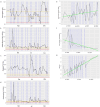Metastatic neuroendocrine carcinoma in inguinal region complicated with membranous nephropathy: a case report
- PMID: 40715854
- PMCID: PMC12301285
- DOI: 10.1007/s12672-025-03097-8
Metastatic neuroendocrine carcinoma in inguinal region complicated with membranous nephropathy: a case report
Abstract
Neuroendocrine neoplasms (NENs) are rare, malignant tumors characterized by variable incidence rates globally, with an overall trend of increasing frequency. The gastrointestinal tract and lungs are the most common primary sites for NENs. Between 11% and 22% of NENs present without an identifiable primary site, with the liver being the most frequent site for metastases. However, metastasis to the inguinal lymph nodes remains uncommon. Tumor-associated kidney disease can occur in association with both solid tumors and hematologic malignancies. Membranous nephropathy is the most prevalent pathological type of tumor-associated kidney disease in patients with solid tumors, and its occurrence in patients with neuroendocrine carcinoma is extremely rare. This article discusses the case of a 72-year-old male patient with metastatic neuroendocrine carcinoma of unknown primary origin, presenting with inguinal metastasis and membranous nephropathy. It details the patient's clinical presentation, diagnostic process, treatment plan, and prognosis, with the goal of increasing awareness and understanding of this rare condition and reviewing pertinent literature.
Keywords: Case report; Membranous nephropathy; Neuroendocrine neoplasms; Unknown primarytumor.
© 2025. The Author(s).
Conflict of interest statement
Declarations. Ethics approval and consent to participate: The research was ethically approved by the First Affiliated Hospital of Nanjing Medical University. Prior to participation, participant was duly informed of her rights and responsibilities and provided explicit written consent. The study was conducted in. agreement with the guidelines governing research involving human participants, as outlined by the Ethics Committee of the First Affiliated Hospital of Nanjing Medical University. Consent for publication: The authors have obtained written consent to publish the images/details of the individual(s) included in this manuscript. Competing interests: The authors declare no competing interests.
Figures





References
-
- Pavel M, O’Toole D, Costa F, et al. ENETS consensus guidelines update for the management of distant metastatic disease of intestinal, pancreatic, bronchial neuroendocrine neoplasms (NEN) and NEN of unknown primary site. Neuroendocrinology. 2016;103:172–85. 10.1159/000443167. - PubMed
-
- Ronco P, D. BL. H. Membranous nephropathy. Nat Rev Dis Primers. 2021;7:69.10.1038/s41572-021-00303-z - PubMed
-
- Ashman N, Steele JPC, Sheaff M, et al. Membranous nephropathy resolving with treatment of bronchial carcinoid tumor. Am J Kidney Diseases. 2000;36 10.1053/ajkd.2000.16214 - PubMed
LinkOut - more resources
Full Text Sources
